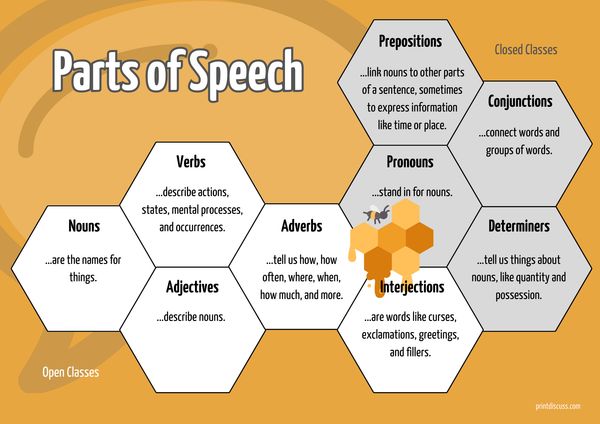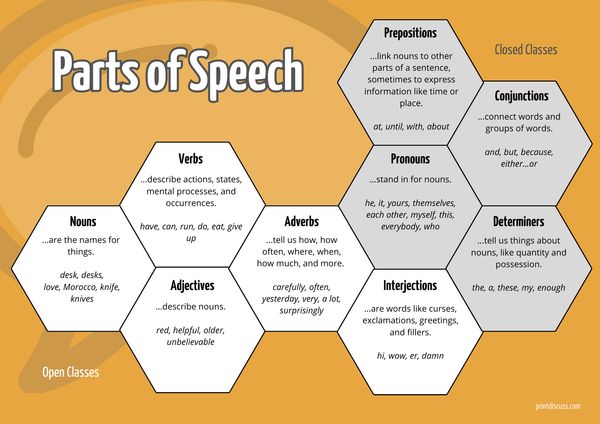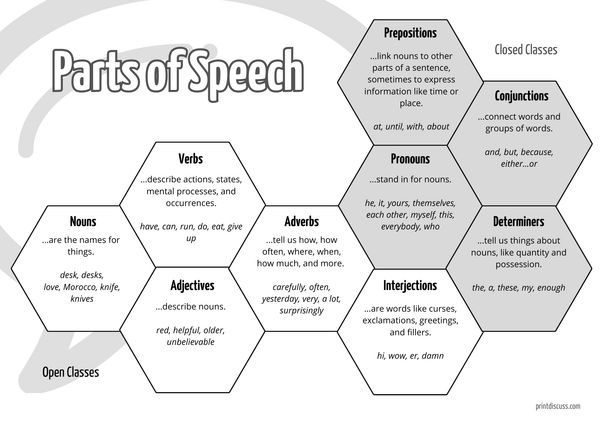The Parts of Speech for ESL Teaching
ESL teachers ought to know English grammar, at least to some degree. A potential first step in that direction is knowing the parts of speech. Many other concepts in grammar build upon this way of classifying words in the English language.
Along with knowledge of the verb tenses, familiarity with the parts of speech is one of the best ways to connect with students on an abstract level as they learn English. It’s not an exaggeration to say that words like verb and noun come up in every single class I teach.
However, as I said about tenses, there is friction between attempts to describe language and attempts to teach it. If you search for part-of-speech graphics online, you will find declarations of both eight and nine parts of speech (for my version of such graphics, go to the end). Meanwhile, linguists can get much more granular and extend out the number of categories to include ones that have no place in the ESL classroom.
A common point of divergence when looking at ESL graphics online (as some indication of what teachers are teaching) is the inclusion or omission of article as a separate category. It’s tempting to set articles apart, given how large they loom for English learners (large, and ominous). At the same time, articles have often been categorized as a type of adjective. Neither of those options appeal to me. I prefer the categorization of articles (a, an, the) as determiners as one of the parts of speech.
It’s worth noting that small categories like particle and postposition are routinely omitted as parts of speech for practical purposes (they don’t have many members, and the members they do have can be captured by the other categories).
Also, words can often be classed in more than one category, and sometimes in several. For example, the word advance is a noun (the latest scientific advance) and a verb (our society is advancing all the time), but it can also work as an adjective (an advanced civilization). Keeping track of these permutations can be difficult for students.
Parts of Speech
Nouns
Nouns are the names for all kinds of things. In a given text, nouns convey most of the meaning. It helps to know about countable and uncountable nouns, regular and irregular plural forms, and proper nouns.
Examples: desk, desks, love, Morocco, knife, knives.
Verbs
Verbs describe actions, states of being, mental processes, and occurrences. They can carry a lot of meaning, and sometimes they carry very little. There is a lot for students to learn, such as various verb types:
- main and helper (auxiliary)
- state and action
- transitive and intransitive
- modal helper (auxiliary)
- phrasal
Language learners must know how to conjugate each verb so that it agrees with the subject of a sentence. Importantly, they should also know participle forms and how to change the verbs according to tense.
Examples: have, can, run, do, eat, give up.
Adjectives
Adjectives describe nouns and pronouns by giving us extra information about them. Students are introduced to comparative forms (eg. bigger) and superlative forms (the tallest) relatively early. They may continue making errors in this area as they otherwise progress.
Examples: red, helpful, older, unbelievable.
Adverbs
Adverbs answer questions like how, how much, how often, why, when, where, and the speaker’s attitude toward what they are talking about. It helps to look at adverbs further divided into subcategories:
- Adverbs of Manner say how something is done
She carefully pulled out the gun. - Adverbs of Frequency show how often something happens
We often talked about politics. - Adverbs of Time and Place
I shouldn’t stay here.
What did you do yesterday? - Adverbs of Degree make adjectives and other adverbs stronger or weaker
I’m very thirsty.
It’s quite good. - Adverbs of Quantity
He smokes a lot.
She drinks a little. - Focusing Adverbs narrow focus or refer to previously mentioned information
They are particularly boring.
I’m a doctor, too! - Attitude Markers show our attitude to events or how we understand them.
Surprisingly, they offered him the job.
Adverbs appear in different places in sentences, which can be challenging to students.
Interjections
Interjections are words like curses, exclamations, brief responses, greetings and fillers that sit apart from the grammatical logic of a sentence. They can appear outside and inside sentences. Inside sentences, they should be set apart from the rest of the sentence with brackets or commas.
- Awww! She’s so cute!
- Wow, that’s impressive.
- But, hey, at least I tried.
The above categories, except for auxiliary verbs, are considered open classes in that they receive new additions as the language changes. The following categories are considered closed as they don’t change regularly.
Pronouns
Pronouns stand in for nouns, and they should refer to a noun that the listener or reader is aware of. In many cases, they help us avoid saying a noun over and over, which would sound repetitive.
There are several types of pronouns. Most of the types are given in the following examples:
- (subject) He has a PhD in Economics.
- (object) Mary hit it with all her strength.
- (possessive) The big present is yours.
- (reflexive) They congratulated themselves.
- (reciprocal) His brothers do not like each other.
- (intensive) I made these cookies myself.
- (demonstrative) This is the correct answer.
- (indefinite) Everybody is tired of this government.
- (relative) The guy who stopped by was an old friend from school.
Prepositions
Prepositions help express meanings like place, time, and more. Sometimes they are just linking words without meaning. They frequently come before noun phrases, but they always relate to a noun or pronoun (which may have appeared earlier in the sentence).
- (place) I met her at the station.
- (time) We work until 4pm.
- (instrument) He works with clay.
- (linking) What are you complaining about?
Conjunctions
Conjunctions connect words, phrases, and clauses. There are a few types (with examples in brackets): coordinating (and, but, etc), subordinating (if, after, because, etc), and correlative (either … or, not only … but also, etc).
- (coordinating) I have a son and a daughter.
- (coordinating) We like pizza, but we’re dieting these days.
- (subordinating) I jumped in the pool because my hair was on fire.
- (correlative) We’ll either leave late at night or early in the morning.
Determiners
Determiners inform us about nouns in several ways. They tell us things like quantity, proximity to the speaker, and possession. They help us know when a person is talking about things in general or about a specific thing. Types of determiners include articles, demonstratives, possessives, quantifiers, and numbers.
- (article) Have you been to the restaurant on the waterfront?
- (demonstrative) Are these your shoes?
- (possessive) I lost my phone.
- (quantifier) They have enough helpers.
Parts of Speech Graphics
Now, behold my attempts at helpful graphics:

Download the above image as an easily printable PDF.

Download the above image as an easily printable PDF.

Download the above image as an easily printable PDF.